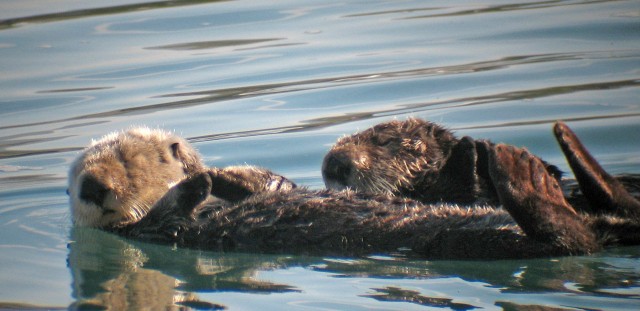Otters get the flu, too
Research shows that sea otters have gotten sick with H1N1, also known as swine flu
Katherine Ellen Foley • December 26, 2014

Sea otters hold hands while they sleep to keep from floating away at night. [Image credit: Flickr user K Schneider]
Meet Luna: She’s a rescued sea otter pup now living at the Shedd Aquarium in Chicago. In September of this year, she was found abandoned on a beach in California. After waiting a night to make sure that her mother was gone (and not just foraging for food), members of the Monterey Bay Aquarium Sea Otter Program took the 2-pound baby into the safe care of veterinarians at their sea otter rehab center, and in October she moved to the Shedd Aquarium.
No one is sure what happened to Luna’s mother, who would normally stay with Luna for six months until she could swim and hunt on her own. Scientists know that great white sharks and killer whales prey on sea otters, and that oil spills and other kinds of habitat loss pose a threat to otters’ survival. The animals are already classified as “endangered.” But other research suggests that certain human viruses may also be a risk for this marine mammal’s health.
A study published this year by the Centers for Disease Control and Prevention and the U.S. Geological Survey found that sea otters on the coast of Washington may have come down with H1N1, or swine flu, which was the rare off-season flu that hit the U.S. in 2009. In 2011, scientists took samples of serum — part of the blood that contains proteins and helps with clotting — from 30 healthy otters that were 2 to 19 years old. In 70 percent of these samples, they found antibodies for the H1N1 virus. Antibodies are the body’s way of fighting off infection; the fact that they were present in otters means that the otters came down with this particular strand of flu, but later recovered.
To make sure that these antibodies were unique to swine flu, scientists looked at the levels of antibodies for other viruses, and compared their results to other samples that had been taken back in 2001. In the 2011 samples, the swine flu antibodies were higher than other types of flu virus, and they weren’t present in the samples from a decade before. Previously, the only other marine mammals known to be susceptible to human strains of the flu was the elephant seal, but scientists still aren’t sure how these different types of marine mammals were exposed to the virus.
Even though these otters survived their brush with the flu, there’s still a question about what kind of effect human viruses could have on marine ecosystems. In this study, scientists were only looking at otters that survived the flu; it’s possible that others died, and were then eaten or decomposed before they could be accounted for. Scientists also don’t know if sea otters are susceptible to other kinds of human viruses.
It’s easy to see why Luna and other lost otters have a huge public appeal. Aside from being adorable and playful, sea otters are fascinating water mammals: They have a million hairs per square inch on their bodies to keep them warm in the frigid ocean waters. They use rocks as eating utensils to crack open prey with shells, such as crabs and muscles. A group of them is called a “raft.”
More importantly, research shows that otters play a crucial role in the balance of sea life because they control invertebrate populations and keep kelp forests healthy. If otters aren’t around to do so, coastal ecosystems could become irreversibly off-balance.
Luna, who will be raised in captivity, probably won’t face the same risks of catching the flu, and if she does, she’ll have the best veterinary care possible. Scientists still aren’t sure how much of an impact the flu and potentially other human viruses will have on wild otters, or their marine homes. Hopefully, it’s nothing some otter tender loving care can’t cure.
*Correction, Jan. 6, 2015:
Originally, this article incorrectly stated how Luna was discovered and went directly to Shedd Aquarium. She was discovered in California, and spent about a month at Monterey Bay Aquarium before traveling to Shedd. Also, a group of sea otters is called a “raft,” while a “romp” refers to a group of river otters.
3 Comments
> they took the 2-pound baby into the safe care of veterinarians at the Shedd Aquarium’s otter rehab center, where she’s been recovering.
-This is not true. They take the pup to Monterey Bay Aquarium first and took care of the pup for a month. It was after that when the pup was taken to Shedd aquarium.
>A group of them is called a “romp.”
-A group of sea otters is called a “raft”.
A group of sea otters is called a “raft”. “Romp” refers to a group of otters (typically some species of river otter) on land.
Flu is not a minor illness and it will leads death sometimes.